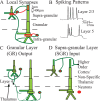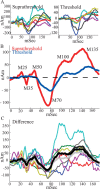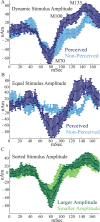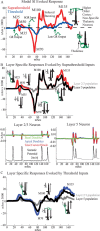Neural correlates of tactile detection: a combined magnetoencephalography and biophysically based computational modeling study
- PMID: 17913909
- PMCID: PMC2867095
- DOI: 10.1523/JNEUROSCI.0482-07.2007
Neural correlates of tactile detection: a combined magnetoencephalography and biophysically based computational modeling study
Abstract
Previous reports conflict as to the role of primary somatosensory neocortex (SI) in tactile detection. We addressed this question in normal human subjects using whole-head magnetoencephalography (MEG) recording. We found that the evoked signal (0-175 ms) showed a prominent equivalent current dipole that localized to the anterior bank of the postcentral gyrus, area 3b of SI. The magnitude and timing of peaks in the SI waveform were stimulus amplitude dependent and predicted perception beginning at approximately 70 ms after stimulus. To make a direct and principled connection between the SI waveform and underlying neural dynamics, we developed a biophysically realistic computational SI model that contained excitatory and inhibitory neurons in supragranular and infragranular layers. The SI evoked response was successfully reproduced from the intracellular currents in pyramidal neurons driven by a sequence of lamina-specific excitatory input, consisting of output from the granular layer (approximately 25 ms), exogenous input to the supragranular layers (approximately 70 ms), and a second wave of granular output (approximately 135 ms). The model also predicted that SI correlates of perception reflect stronger and shorter-latency supragranular and late granular drive during perceived trials. These findings strongly support the view that signatures of tactile detection are present in human SI and are mediated by local neural dynamics induced by lamina-specific synaptic drive. Furthermore, our model provides a biophysically realistic solution to the MEG signal and can predict the electrophysiological correlates of human perception.
Figures






Similar articles
-
Quantitative analysis and biophysically realistic neural modeling of the MEG mu rhythm: rhythmogenesis and modulation of sensory-evoked responses.J Neurophysiol. 2009 Dec;102(6):3554-72. doi: 10.1152/jn.00535.2009. Epub 2009 Oct 7. J Neurophysiol. 2009. PMID: 19812290 Free PMC article.
-
Transformations in oscillatory activity and evoked responses in primary somatosensory cortex in middle age: a combined computational neural modeling and MEG study.Neuroimage. 2010 Sep;52(3):897-912. doi: 10.1016/j.neuroimage.2010.02.004. Epub 2010 Feb 10. Neuroimage. 2010. PMID: 20149881 Free PMC article.
-
Parallel processing in cerebral cortex of the marmoset monkey: effect of reversible SI inactivation on tactile responses in SII.J Neurophysiol. 1996 Dec;76(6):3633-55. doi: 10.1152/jn.1996.76.6.3633. J Neurophysiol. 1996. PMID: 8985863
-
The somatosensory evoked magnetic fields.Prog Neurobiol. 2000 Aug;61(5):495-523. doi: 10.1016/s0301-0082(99)00063-5. Prog Neurobiol. 2000. PMID: 10748321 Review.
-
Tracking functions of cortical networks on a millisecond timescale.Neural Netw. 2000 Oct-Nov;13(8-9):883-9. doi: 10.1016/s0893-6080(00)00061-7. Neural Netw. 2000. PMID: 11156199 Review.
Cited by
-
Spatial attention modulates tactile change detection.Exp Brain Res. 2013 Jan;224(2):295-302. doi: 10.1007/s00221-012-3311-5. Epub 2012 Oct 30. Exp Brain Res. 2013. PMID: 23109085
-
Recurrent neural processing and somatosensory awareness.J Neurosci. 2012 Jan 18;32(3):799-805. doi: 10.1523/JNEUROSCI.3974-11.2012. J Neurosci. 2012. PMID: 22262878 Free PMC article.
-
Neural basis of somatosensory target detection independent of uncertainty, relevance, and reports.Elife. 2019 Mar 29;8:e43410. doi: 10.7554/eLife.43410. Elife. 2019. PMID: 30924769 Free PMC article.
-
Open Ephys electroencephalography (Open Ephys + EEG): a modular, low-cost, open-source solution to human neural recording.J Neural Eng. 2017 Jun;14(3):035002. doi: 10.1088/1741-2552/aa651f. Epub 2017 Mar 7. J Neural Eng. 2017. PMID: 28266930 Free PMC article.
-
Frequency specific modulation of human somatosensory cortex.Front Psychol. 2011 Feb 2;2:13. doi: 10.3389/fpsyg.2011.00013. eCollection 2011. Front Psychol. 2011. PMID: 21713181 Free PMC article.
References
-
- Allison T, Goff WR, Williamson PD, VanGilder JC. On the neural origin of early components of the human somatosensory evoked potential. In: Desmedt JE, editor. Clinical uses of cerebral, brain-stem and spinal somatosensory evoked potentials. Progress in clinical neurophysiology. Basel: Karger; 1980. pp. 51–68.
-
- Arezzo J, Legatt AD, Vaughan HG., Jr Topography and intracranial sources of somatosensory evoked potentials in the monkey. I. Early components. Electroencephalogr Clin Neurophysiol. 1979;46:155–172. - PubMed
-
- Arezzo JC, Vaughan HG, Jr, Legatt AD. Topography and intracranial sources of somatosensory evoked potentials in the monkey. II. Cortical components. Electroencephalogr Clin Neurophysiol. 1981;51:1–18. - PubMed
-
- Bannister AP. Inter- and intra-laminar connections of pyramidal cells in the neocortex. Neurosci Res. 2005;53:95–103. - PubMed
-
- Barth DS, Di S. Laminar excitability cycles in neocortex. J Neurophysiol. 1991;65:891–898. - PubMed
Publication types
MeSH terms
Grants and funding
LinkOut - more resources
Full Text Sources
Medical
Molecular Biology Databases
